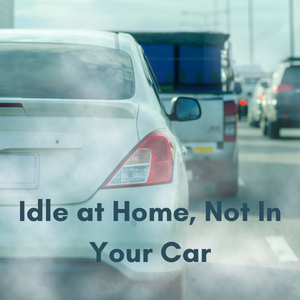
As we say farewell to this holiday season, many of us may feel the need to put our feet up and relish being still for a moment. While it may be the perfect time of year to find ways to idle at home, sitting in your car idling is a sure fire way to add to the toxic pollution in the planet and the air we breathe.
Why is it ok to idle at home but not in your car?
According to the US Department of Energy, annually personal vehicle idling generates around 30 million tons of CO2 — the equivalent of taking 5 million vehicles off the road. Did you know that idling for more than ten seconds uses more fuel and creates more CO2 than just restarting your engine?
Idling is not just a planet problem, it’s a people problem too. Outside the car, idling tailpipes spew out the same pollutants as moving cars. Pollutants from idling have been linked to human illnesses including asthma, heart disease, chronic bronchitis, and cancer. Particularly vulnerable to these illnesses are children because vehicle emissions are more concentrated near the ground where children breathe. Their lungs can be damaged more easily compared to adult lungs.
According to the Environmental Defense Fund, occupants in an idling car will breathe more dirty exhaust that leaks into the car cabin — the short term benefit of a warm car is not worth the long-term risks to your health.
You only have to travel a short distance to look at the idling effect right in our own backyard. Our track record in Connecticut speaks volumes on the toxic air we breathe every day. According to the American Lung Association’s 2022 State of the Air report, Connecticut bears the unfortunate burden of being known as the “tailpipe of the nation”. Every county in Connecticut received a poor grade for ozone levels; in particular, Fairfield, Middlesex, New Haven and New London all received a grade F.
Did you know idling is illegal in Connecticut?
29 states including Connecticut adopted laws to make idling illegal. In Wilton, Wilton Go Green worked to bolster the state law by passing a No Idling Resolution in 2015 with full support of town leadership. The law prohibits idling for more than three minutes, except under extreme weather, and applies to all vehicles including commercial vehicles like school buses. As a result, you may notice no idling, green signs around town and at schools as a friendly reminder.
What perceptions do we hold that keep us from turning off our engines instead of idling?
Misperception #1 – Letting my car warm up is good for its engine.
Fact: Car manufacturers agree that even on the coldest days, a car’s catalytic converter is optimal “at work” versus standing.
Misperception #2 – On a cold day, it takes too long to warm up my car unless I let it idle first.
Fact: A driving vehicle reaches its ideal operating temperature faster by driving than idling. In fact, your vehicle warms up twice as fast in motion than running at rest.
Misperception #3 – I save more money on gas by idling versus re-starting my car
Fact: Contrary to perception, starting a car burns less fuel and emits less CO2 than idling your car. In America, we empty our wallets by spending a whopping $13 million every day on gasoline by idling.
Misperception #4 – Starting and restarting my car will wear out the engine more quickly.
Contrary to popular belief, idling can damage engine components. According to the California Energy Commission, “Fuel is only partially combusted when idling because an engine does not operate at its peak temperature. This leads to the build-up of fuel residues on cylinder walls that can damage engine components and increase fuel consumption.” Many new cars also come with the Auto-Start/Stop function. This automatically starts and stops the engine when a car comes to a stop while in driving mode. Keeping the auto-start/stop function activated has proven to save money at the fuel pump while reducing emissions in the atmosphere.
Being mindful is the first step to an Idle-Free Life (in the car)
- Turn your car off after ten seconds of idling
- Warm your car up the safe and most efficient way by easing into driving instead of standing still with the engine on
- Cover kids in cozy blankets to beat the cold
- Leave windows open and keep kids outside of the car as best as possible to avoid the heat in warmer weather
- Use post it notes in your car as a reminder to make no idling a habit
- Keep the Auto-Start/Stop function in your car activated – save gas and the planet at the same time!
By being mindful of the harmful effects of idling, together we can create a win-win-win scenario — keeping our air clean, protecting the health and well-being of our community and reaping the benefits of preserving vehicle efficiencies including less money at the fuel pump.
